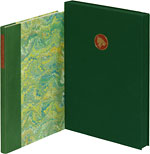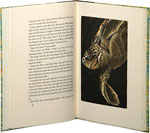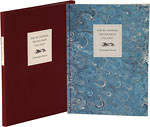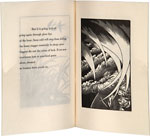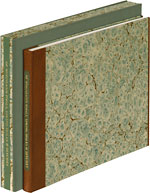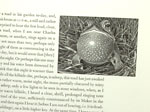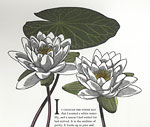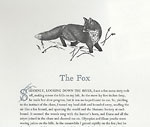At Home in the Natural World
Abigail Rorer’s Lone Oak Press
By Richard Goodman
There must be some kind of precociousness going on here.
When you have an artist who learned the intricacies of color in multi-block wood engraving because of a mistake, and, just ten years later, is “the most outstanding engraver in the country that I know of, and one of the best in the world for that matter,” according to the iconic Barry Moser, then it must be something close to that.
How did Abigail Rorer get there? Before she founded The Lone Oak Press in 1989, Abigail Rorer had been an illustrator (she still is) for other presses for years. The work she did included illustrations for Barbarian Press, The Press on Scroll Road, Aralia Press, university presses, and major publishing houses such as Little, Brown, Henry Holt and University of Massachusetts Press. This work consisted mostly of pen and ink drawings, hand colored etchings, and black and white woodblock prints. Three of those works she illustrated for other publishers were by Henry David Thoreau, an exposure that would have large consequences for Rorer.
She started Lone Oak Press “because,” she said, “I love books and wanted the freedom to make a book and illustrate it without editorial restrictions.” Her first book on her own was Three Coyote Tales (1989), with five vivid, striking hand-colored etchings. One, of a turtle swimming, is especially memorable. You feel as if you’re inside this antediluvian creature’s mind. But if you look closely at the thumb-sized black-and-white woodblock spots that accent the text here and there, they impress as much, and even more, than the full-page etchings. You can’t get them out of your mind. They seem the result of an artist who has found her home.
Next up for Rorer and Lone Oak was The Wu General Writes from Far Away (1990), a poem by Christopher Howell. It’s illustrated with a series of black-and-white wood engravings. Rorer printed the engravings—and the etchings from Coyote Tales as well—herself, but she left the printing of the text and spots to Darrell Hyder of the Sun Hill Press. She did, however, design both books. “That’s why the designs are boring,” she declared matter-of-factly. She did not take that task upon herself again.
The next Lone Oak Press book wouldn’t come forth until 2005, and is the result of the aforementioned exposure to Thoreau. She had illustrated three books by the author of Walden for other presses. “I also began a growing friendship with Bradley Dean, the editor of two of the books. The more I worked on the Thoreau books, the more I discussed Thoreau and his work with Brad, the more I came to…feel a real kinship with his passion for nature….I thought I would like to do a book on the springtime phenomena of vernal pools with excerpts from Thoreau’s Journal.”
The result is Of Woodland Pools, Spring-holes & Ditches (2005). It’s illustrated with a series of black and white wood engravings, many of frogs—swimming, croaking, peering and mating. This time, Rorer gave up the designing, along as well as the printing, of the text to Michael Russem of Kat Ran Press (See FB&C November/December 2004)
Of Woodland Pools, Spring-holes & Ditches is the work of an artist who, to alter George Santayana’s quote slightly, “has taken the measure of her powers, tasted the fruits of her passions and learned her place in the world and what things in it can really serve her.” It’s a beautifully illustrated and beautifully designed book. There is, though, just one print with color. Why? “I tried adding some color,” Rorer answered, “but I felt the illustrations were just so beautiful in black and white.”








